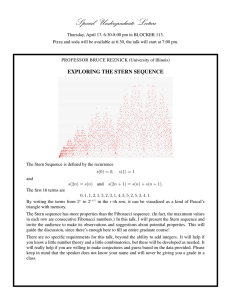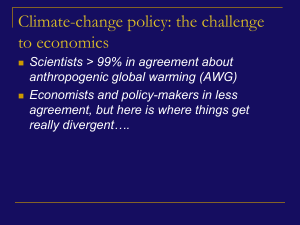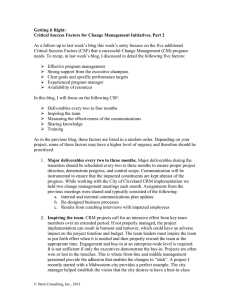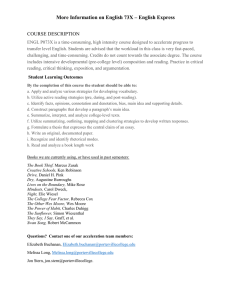H
advertisement
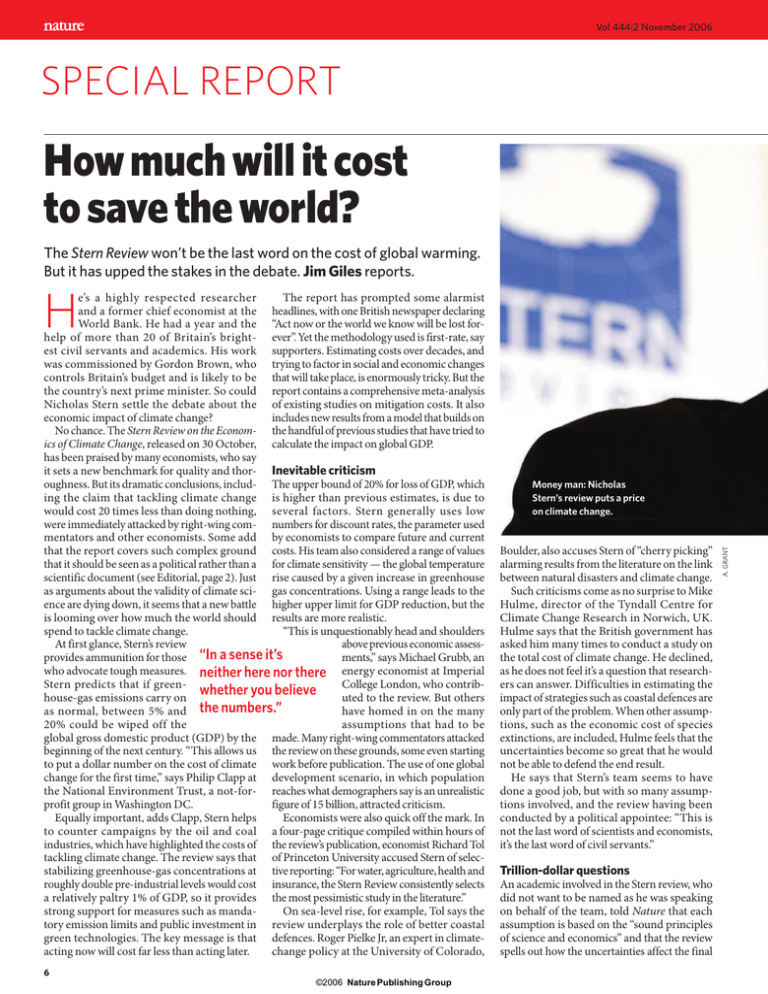
Vol 444|2 November 2006 SPECIAL REPORT How much will it cost to save the world? The Stern Review won’t be the last word on the cost of global warming. But it has upped the stakes in the debate. Jim Giles reports. e’s a highly respected researcher The report has prompted some alarmist and a former chief economist at the headlines, with one British newspaper declaring World Bank. He had a year and the “Act now or the world we know will be lost forhelp of more than 20 of Britain’s bright- ever”. Yet the methodology used is first-rate, say est civil servants and academics. His work supporters. Estimating costs over decades, and was commissioned by Gordon Brown, who trying to factor in social and economic changes controls Britain’s budget and is likely to be that will take place, is enormously tricky. But the the country’s next prime minister. So could report contains a comprehensive meta-analysis Nicholas Stern settle the debate about the of existing studies on mitigation costs. It also economic impact of climate change? includes new results from a model that builds on No chance. The Stern Review on the Econom- the handful of previous studies that have tried to ics of Climate Change, released on 30 October, calculate the impact on global GDP. has been praised by many economists, who say it sets a new benchmark for quality and thor- Inevitable criticism oughness. But its dramatic conclusions, includ- The upper bound of 20% for loss of GDP, which ing the claim that tackling climate change is higher than previous estimates, is due to would cost 20 times less than doing nothing, several factors. Stern generally uses low were immediately attacked by right-wing com- numbers for discount rates, the parameter used mentators and other economists. Some add by economists to compare future and current that the report covers such complex ground costs. His team also considered a range of values that it should be seen as a political rather than a for climate sensitivity — the global temperature scientific document (see Editorial, page 2). Just rise caused by a given increase in greenhouse as arguments about the validity of climate sci- gas concentrations. Using a range leads to the ence are dying down, it seems that a new battle higher upper limit for GDP reduction, but the is looming over how much the world should results are more realistic. spend to tackle climate change. “This is unquestionably head and shoulders At first glance, Stern’s review above previous economic assessprovides ammunition for those “In a sense it’s ments,” says Michael Grubb, an who advocate tough measures. neither here nor there energy economist at Imperial Stern predicts that if greenCollege London, who contribwhether you believe house-gas emissions carry on uted to the review. But others as normal, between 5% and the numbers.” have homed in on the many 20% could be wiped off the assumptions that had to be global gross domestic product (GDP) by the made. Many right-wing commentators attacked beginning of the next century. “This allows us the review on these grounds, some even starting to put a dollar number on the cost of climate work before publication. The use of one global change for the first time,” says Philip Clapp at development scenario, in which population the National Environment Trust, a not-for- reaches what demographers say is an unrealistic profit group in Washington DC. figure of 15 billion, attracted criticism. Equally important, adds Clapp, Stern helps Economists were also quick off the mark. In to counter campaigns by the oil and coal a four-page critique compiled within hours of industries, which have highlighted the costs of the review’s publication, economist Richard Tol tackling climate change. The review says that of Princeton University accused Stern of selecstabilizing greenhouse-gas concentrations at tive reporting: “For water, agriculture, health and roughly double pre-industrial levels would cost insurance, the Stern Review consistently selects a relatively paltry 1% of GDP, so it provides the most pessimistic study in the literature.” strong support for measures such as mandaOn sea-level rise, for example, Tol says the tory emission limits and public investment in review underplays the role of better coastal green technologies. The key message is that defences. Roger Pielke Jr, an expert in climateacting now will cost far less than acting later. change policy at the University of Colorado, H 6 ©2006 Nature Publishing Group Boulder, also accuses Stern of “cherry picking” alarming results from the literature on the link between natural disasters and climate change. Such criticisms come as no surprise to Mike Hulme, director of the Tyndall Centre for Climate Change Research in Norwich, UK. Hulme says that the British government has asked him many times to conduct a study on the total cost of climate change. He declined, as he does not feel it’s a question that researchers can answer. Difficulties in estimating the impact of strategies such as coastal defences are only part of the problem. When other assumptions, such as the economic cost of species extinctions, are included, Hulme feels that the uncertainties become so great that he would not be able to defend the end result. He says that Stern’s team seems to have done a good job, but with so many assumptions involved, and the review having been conducted by a political appointee: “This is not the last word of scientists and economists, it’s the last word of civil servants.” Trillion-dollar questions An academic involved in the Stern review, who did not want to be named as he was speaking on behalf of the team, told Nature that each assumption is based on the “sound principles of science and economics” and that the review spells out how the uncertainties affect the final A. GRANT Money man: Nicholas Stern’s review puts a price on climate change. M. TURKIA/AFP/GETTY NEWS NATURE|Vol 444|2 November 2006 MEDICS ON TRIAL Follow events in Libya, where medics stand accused of infecting children with HIV. www.nature.com/news Kyoto looks to the future result. He adds that the involvement of civil servants does not justify the “dangerous and incorrect” allegation that the report is politicized: “There was never any political pressure to produce high numbers.” The inevitable criticisms of the review need not reduce its impact. Negotiations over the future of the Kyoto Protocol are taking place this week (see ‘Kyoto looks to the future’), and the review will strengthen the case of countries like Britain, which want tough limits on future emissions. Stern discusses several ways in which this could be done; one suggestion, that the current European Union emission-trading scheme be made global, was backed by Brown at the review’s launch. Stern also notes that a substantial hike in public energy-research spending is needed, as market factors alone will not drive the development of technologies such as improved solar cells and biofuels that are needed to reduce emissions. Stimulating debate over spending decisions, rather than putting a figure on the true costs of climate change, may be the review’s main legacy. Although Hulme questions the assumptions behind the headline result, he has no doubt that Stern is broadly correct: “In a sense it’s neither here nor there whether you believe the numbers. This will take the discourse away from the costs of taking action and put attention onto the costs of inaction.” ■ Next week, thousands of delegates from more than 180 countries will fly to Nairobi, Kenya, for talks about the Kyoto Protocol on climate change. Is this an exercise in futile bureaucracy, as some critics claim, or will it break new diplomatic and economic ground? Kyoto has polarized opinion since its conception. The treaty calls for signatories to make an average 5% reduction (relative to 1990 levels) of greenhouse-gas emissions by 2012. Only developed countries are required to make cuts, so major developing nations such as China, India and Brazil are not included. In 2001, the United States and Australia dropped out, claiming that the protocol would overburden their domestic economies. The treaty finally came into force in 2005, when Russia signed up and the countries committing to targets accounted for 55% of 1990 emissions. The first period during which countries’ emissions will be measured and assessed is 2008–12. But several mechanisms are already in place. Europe started a mandatory emissions-trading system in January 2005, allowing carbon-hungry companies to buy credits from companies with emissions to spare. It’s unclear whether the scheme has lowered emissions, and critics say the carbon allowances were set too high. But the principle is seen as a success, and the market could become the nucleus of a global emissionstrading scheme. Kyoto also gives credits to industrialized countries for helping poorer countries reduce or lock away emissions, for example by funding alternative energy or reforestation projects. The Clean Development Mechanism (CDM), launched last year, covers developing countries, and the Joint Implementation (JI) mechanism, which covers projects in other industrialized countries such as central and eastern Europe, launched last week. These systems aim to force rich countries to implement real carbon reductions. But critics complain that they allow countries to avoid improving energy efficiency at home, and that the projects target easy savings rather than encouraging investment in new technologies. Still, progress so far looks impressive. Around 4,000 CDM and JI projects are “Canada, Japan and several EU members are lagging behind, and face an enormous effort to catch up.” planned or in place, mostly funded by private investors in the European Union (EU) and Japan. Not all will work out, but if they did they could save the equivalent of 2.2 gigatonnes of carbon dioxide — around seven times the amount that the EU needs to save by 2012. These mechanisms will be needed. Many Kyoto countries, including Canada, Japan and several EU members, are lagging well behind target, and face an enormous effort to catch up. The reasons vary. Japan’s growing industry is emitting 8% more greenhouse gases than in 1990, so now needs a 14% cut by 2012. In Canada, changes of government and the desire to profit from oil deposits in Alberta, have led to Kyoto slipping off the agenda. In March, it became the first country to say that it probably will not meet its 2012 target. ©2006 Nature Publishing Group Italy, Spain, Austria and Finland are also having trouble, so as the 2012 date gets closer, many will be looking to buy credits to make up the shortfall. One potential bump in the road is that Russia and Ukraine, whose emissions went down sharply after the political and economic collapse of the Soviet Union, are likely at some point to sell their surplus allowances. If they sell too much too fast, the price of carbon could drop drastically. Another problem is that it is not clear how Kyoto will determine who has met their targets, and what happens to countries that have not. The rules say that countries missing their targets will be suspended from carbon trading and must make up the shortfall, plus a 30% penalty, in the second commitment period after 2012. But the Kyoto compliance committee has not yet decided how to measure countries’ carbon emissions, or how to enforce measures on those that do not comply. It has not even issued an early warning to countries running the risk of falling short. With so much uncertainty, it is unclear whether countries will have an incentive to make the tough decisions needed to hit targets. Emission assessment and compliance will both be discussed in Nairobi next week. But a post2012 negotiating session is not even on the agenda. Fed up with the murkiness, some climate-policy analysts now argue that the Kyoto Protocol is not worth continuing with, preferring to look towards a new type of agreement that would have the support of more regions and countries, especially the United States. But whether it survives or not, the treaty is set to provide a solid foundation for future agreements on Quirin Schiermeier climate. 7
